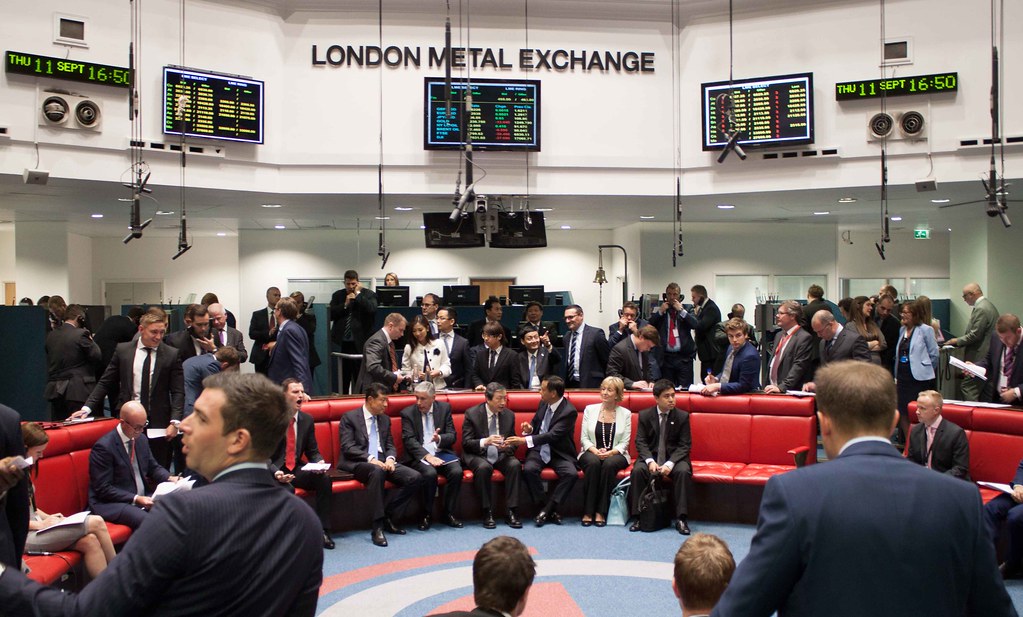LME Week: cocktails, canapés and crises

It’s not the first time the 145-year-old London Metal Exchange (LME) has found itself in crisis.
There was the Tin Crisis of 1986, the Nickel Crisis of 1988, and what at the time was dubbed “The Sumitomo Scandal” but could now better be described as The 1996 Copper Crisis.
This year, however, is still something of a stand-out with not one but two tsunamis rocking the grand old dame of industrial metals trading.
March brought Nickel Crisis II, a much scarier update of the original, and now we have the unfolding Russian Metal Crisis.
Trading volumes have been sliding sharply since the nickel blow-out and there’s lingering uncertainty as to the future of the exchange’s iconic open outcry trading ring.
As metal traders gather for the annual LME Week festivities in London, it’s likely to be the state of the exchange as much as the markets that dominates the agenda.

Turbulent times
The LME’s near breakdown in March mirrors the chaos that has been playing out in physical metal supply chains.
A highly globalized industry has been fractured by covid-19 lockdowns, the ensuing turmoil in the global shipping sector, and the geopolitical stress caused by Russia’s invasion of Ukraine.
Tin was the first to turn wild in February last year, the LME cash premium over three-month metal rocketing to an extraordinary $6,500 per tonne.
Copper was next, the LME having to step in and impose backwardation limits in October as available stocks fell to 14,150 tonnes, enough to feed the global demand for precisely five hours.
Such was the troubled backdrop to the Feb. 24 launch of Russia’s “special military operation” in Ukraine, which triggered nickel’s price melt-up and the near meltdown of the LME clearing system.
The status of Russian metal now poses a major dilemma for the LME, which has issued a discussion paper on whether to suspend Russian brands.
It’s perilous legal territory and would have a significant impact on LME prices and physical premiums. But the risk is that unsold Russian metal floods into the market of last resort, transforming London pricing to Londongrad pricing.
The arrival of 271,800 tonnes of aluminum in LME sheds since the start of the month suggests a decision may have to be made sooner rather than later.
Turbulent times have called for special measures in the form of lending caps and price move limits across all the LME’s deliverable contracts.
They might be in place for a while.
The last time Europe saw equivalent military conflict, the LME suspended trading in 1941. Full service only returned in 1953 with the lifting of government price controls on zinc.
Nickel crisis part II
None of which will persuade either Elliott Associates or Jane Street Global Trading that the LME was right to cancel trades executed on the morning before it stopped nickel trading.
The two fund managers are suing the LME for $456 million and $15.3 million respectively. A group of five others is seeking pre-action disclosure in the British courts.
The LME maintains that it acted in the interests of the broader market and describes the complaints as “without merit”.
It is clear that the LME only took such drastic action because it feared a repeat of the near-death Tin Crisis as exploding nickel margin calls threatened the viability of both brokers and the LME’s own clearing system.
The rights and wrongs will now be the subject of much lawyerly scrutiny.
Also under the spotlight will be LMEClear, the exchange’s clearing house. It under-performed its peers in a recent Bank of England stress test. The test was “exploratory with no pass-fail assessments” but LMEClear’s default fund came close to depletion.
It should, however, come as no surprise that it was nickel that almost broke the LME bank.
The last time the LME halted trading was in 1988 when the official nickel ring descended into chaos as the price hit a liquidity vacuum. An emergency board meeting worked out a lending limit to allow trading to resume and the morning price was scrubbed on the convenient basis it hadn’t traded.
The following years saw an intense industry debate about the shortcomings of the LME contract, which even then represented only a small part of the nickel product spectrum. No solution was found and today’s Class I contract covers an even smaller section of the world’s nickel production.
That’s significant given the major short position holder in March was Tsingshan Group, a massive producer but not in the form of LME-deliverable metal.
Back to basics?
Nickel needs a new pricing mechanism to handle the new products streaming into the electric vehicle battery sector.
Can the LME provide a solution? Or is it more likely to be an Asian exchange, given this is a part of the nickel market dominated by flows of material from Indonesia to China?
Singapore’s SGX has just launched two cobalt and two lithium contracts in an attempt to grab a piece of the battery pie. Nickel is an obvious addition to a regional market that has already moved away from LME pricing.
Meanwhile, CME’s cobalt contract has steadily built up liquidity since its end-2020 launch even as activity in the LME’s contract has steadily dwindled.
The US exchange has also been rolling out new products such as the micro copper contract, which despite its small lot size of 2,500 lb has traded the equivalent of almost 400,000 tonnes in the first five months of activity.
The Shanghai Futures Exchange is trying to reach out to international waters with its INE copper contract, which saw volumes rise by 24% year on year and open interest double through September.
As a globalized industry becomes increasingly regionalized, it’s natural that the LME’s pricing power will be eroded.
Disgruntled funds have already voted with their feet, the collective departure causing LME trading volumes to slide by 6% over the first nine months of this year. They won’t be back until the nickel fiasco is disentangled in court.
But the LME still has a powerful franchise with its existing industrial customer base and it will need to rely on that core if is to prosper again.
It could start by making sure its deliverable contracts still match the needs of the industries it serves. Nickel is a warning of what happens if paper and physical markets disconnect.
Happy LME Week!
(The opinions expressed here are those of the author, Andy Home, a columnist for Reuters.)
(Editing by Kirsten Donovan)
{{ commodity.name }}
{{ post.title }}
{{ post.date }}


Comments